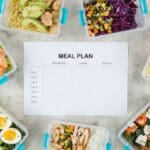Introduction
When it comes to creating an effective weight loss recipe, there’s a lot more to it than just slashing calories. A recipe that actually supports your goals needs to do more than just taste good. You’re looking for a combination of ingredients and techniques that help curb hunger, provide energy, and boost metabolism. But how can you tell if a recipe is truly geared toward weight loss? In this ultimate guide, we’ll uncover the elements that make a weight loss recipe work, giving you insights and tips you can use to create healthy, satisfying meals every time.
What Defines an Effective Weight Loss Recipe?
An effective weight loss recipe doesn’t just focus on cutting calories. It’s designed to fill you up, fuel your body, and keep you satisfied, reducing the chance of overeating. These recipes prioritize ingredients that are high in nutrients and low in empty calories, promoting healthy, sustainable weight loss. Here’s a closer look at some of the key aspects:
- High in Fiber: Fiber is crucial in any weight loss diet as it slows down digestion, keeps you full, and helps prevent overeating.
- Rich in Protein: Protein is essential for maintaining muscle mass, especially when you’re in a calorie deficit. A good weight loss recipe will include lean proteins, such as chicken, tofu, or beans.
- Low in Added Sugars: Added sugars can quickly increase calorie counts and don’t provide any real nutritional benefit. Effective recipes limit or eliminate sugars.
- Moderate in Healthy Fats: Healthy fats from sources like olive oil, avocados, and nuts help keep you satisfied and provide essential nutrients.
- Controlled Portion Sizes: Portion control is key for any weight loss journey, so effective recipes provide guidance on serving sizes.
Top Ingredients to Look For in Weight Loss Recipes
To truly make a recipe work for weight loss, certain weight loss recipe ingredients are essential. These ingredients are not only nutrient-rich but also help support satiety, energy, and metabolism.
- Leafy Greens (Spinach, Kale): Low in calories and high in fiber, leafy greens add volume to meals, keeping you full without adding excessive calories.
- Whole Grains (Quinoa, Brown Rice): Unlike refined grains, whole grains are high in fiber and provide lasting energy, helping reduce cravings.
- Lean Proteins (Chicken, Lentils, Greek Yogurt): Protein takes longer to digest and helps keep hunger at bay, making it easier to stick to a calorie-controlled diet.
- Healthy Fats (Avocado, Olive Oil): These fats are satisfying and help you absorb fat-soluble vitamins.
- Spices and Herbs (Cinnamon, Turmeric): These add flavor without calories, and some, like cinnamon, may even help regulate blood sugar levels.
Cooking Techniques That Enhance Weight Loss Recipes
Beyond ingredients, the way a recipe is prepared can influence its effectiveness for weight loss. Cooking methods that reduce the need for extra fats or oils are particularly beneficial.
- Grilling: This method allows fats to drip away from foods, reducing overall calorie content while enhancing flavor.
- Steaming: Steaming vegetables preserves their nutrients and doesn’t require added fats, making it an ideal technique for weight loss recipes.
- Roasting: When done with minimal oil, roasting can bring out the flavors of vegetables and proteins without adding excessive calories.
- Sautéing with Broth: Instead of cooking with oil, using vegetable or chicken broth can cut down on calories while still adding flavor.

How to Spot a Weight Loss Recipe
A weight loss-friendly recipe typically has a few key indicators. Start by checking the ingredients list and cooking instructions:
- Look for Fiber and Protein: These nutrients help make recipes more filling and effective for weight loss.
- Minimal Processed Ingredients: Recipes that rely on whole, minimally processed ingredients are generally healthier and lower in calories.
- Low Sugar and Salt Content: These can add hidden calories and lead to cravings, so avoid recipes that call for lots of sugar or salt.
- Controlled Portion Sizes: Weight loss recipes should ideally include recommended portion sizes to help with calorie control.
Transform Your Cooking to Support Weight Loss
If you’re looking to transform your cooking to support weight loss, a few small adjustments can make a big difference. By focusing on portion control, high-fiber ingredients, and lean proteins, you can turn any recipe into a weight-loss-friendly option.
- Emphasize Vegetables: Making veggies the star of your dish adds volume without piling on calories. Try adding extra vegetables to pasta dishes, stir-fries, or even omelets.
- Reduce High-Calorie Ingredients: Swap high-calorie ingredients like cream and cheese for lighter options like Greek yogurt or cottage cheese.
- Use Herbs and Spices for Flavor: Instead of adding fats or sugars for flavor, rely on fresh herbs and spices to elevate your dishes.
- Plan Your Meals: Planning meals in advance allows you to make intentional food choices that align with your weight loss goals, preventing impulsive, high-calorie meals.
Common Mistakes to Avoid in Weight Loss Recipes
Even with the best intentions, it’s easy to make mistakes that reduce the effectiveness of a weight loss recipe.
- Using Too Much Oil or Butter: Even healthy oils add calories quickly, so measure carefully and consider non-stick cooking sprays or broth for sautéing.
- Not Paying Attention to Portion Sizes: Eating a larger portion than intended can add unnecessary calories, so follow portion recommendations closely.
- Relying on “Low-Fat” or “Diet” Versions of Foods: Often, these versions are highly processed and contain added sugars or artificial ingredients that may hinder weight loss.
- Skipping Protein: Protein is crucial for satiety and muscle maintenance. Make sure every meal includes a protein source.
Key Takeaways
An effective weight loss recipe combines nutrient-dense ingredients with mindful cooking techniques to support a calorie deficit. By choosing high-fiber, high-protein ingredients, limiting added sugars and unhealthy fats, and practicing portion control, you can create delicious meals that support your weight loss journey.
Conclusion
Losing weight doesn’t mean sacrificing flavor or variety in your meals. With the right ingredients and cooking techniques, you can enjoy a wide range of satisfying dishes that support your goals. Remember, a great weight loss recipe is one that helps you feel full and energized, not deprived. Start incorporating these tips and ingredients into your cooking, and you’ll be well on your way to a healthier, lighter version of yourself!




